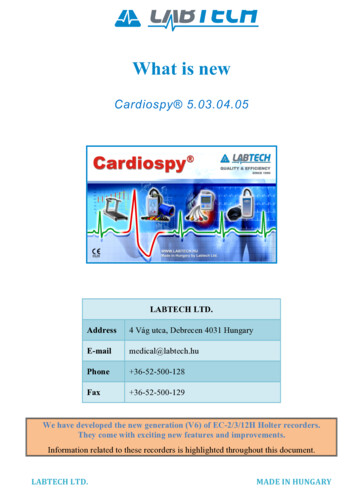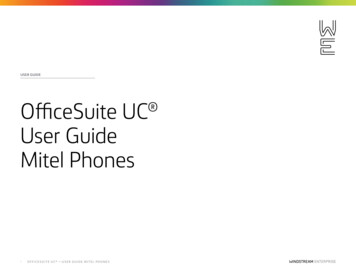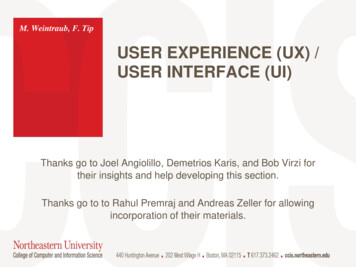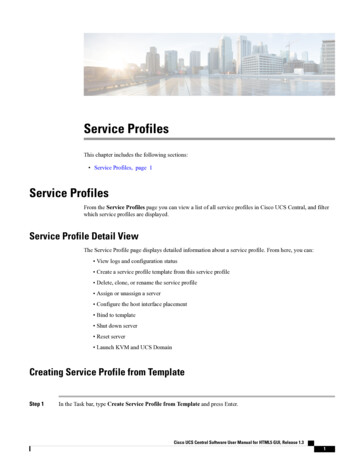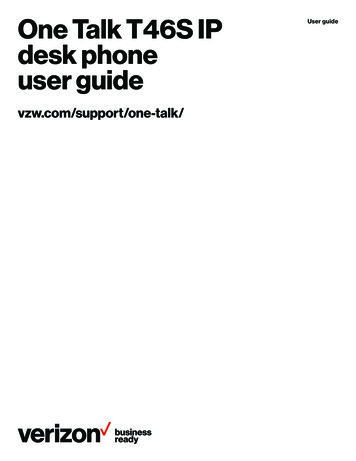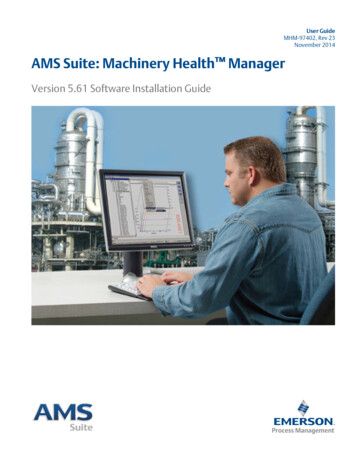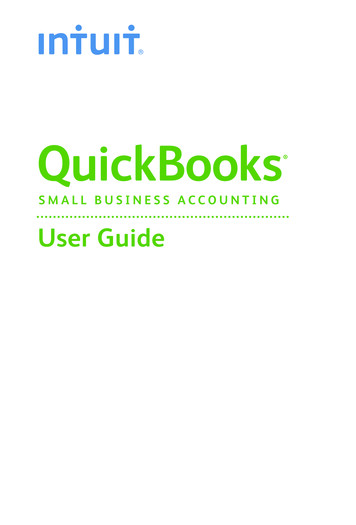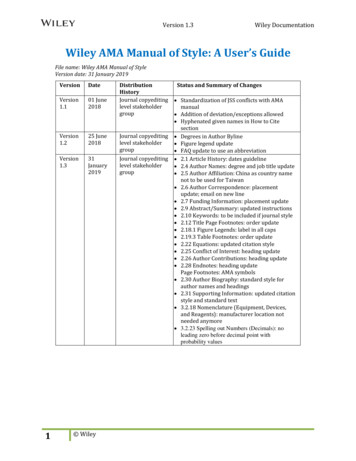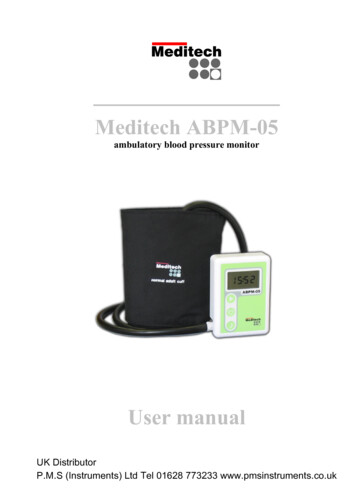
Transcription
Meditech ABPM-05ambulatory blood pressure monitorUser manualUK DistributorP.M.S (Instruments) Ltd Tel 01628 773233 www.pmsinstruments.co.uk
Important information – precautions for use – read carefully!This symbol on a Meditech recorder is a warning that you should readthe accompanying documentation (this manual).The ABPM-05 ambulatory blood pressure recorder is manufactured byMeditech Ltd.200 Ulloi ut, Budapest, Hungaryfax: 36 1 282 9388www.meditech.hue-mail: meditech@meditech.huContact us for further product and service information.Meditech Ltd. maintains a quality assurance system certified accordingto MSZ EN ISO 9001:2000 and MSZ EN ISO 13485:2003.Notified BodyUnit 202b, Worle ParkwayWestern-super-Mare, BS22 0WA!SGS Yarsleyfax: 44 1934 522 137www.sgs.comMeditech ABPM-05 recorders should not be used if any of thefollowing cases apply: patients without an indication for ambulatory blood pressuremonitoring non-cooperative patients patients in any way unable to operate a recorder as intended patients requiring urgency / emergency cardiac care unconscious or otherwise incapable patients patients with serious mobility impairments without supervision patients with coagulation disturbances children without supervision children under the age of 8 years!Though the blood pressure measurement algorithm used in Meditech ABPrecorders has been tested and found to function properly on patients withatrial fibrillation or other common arrhythmias, the oscillometric bloodpressure measurement method is generally recommended for use onlywith special caution in patients with arrhythmias, Parkinson's disease, orother diseases with tremor.!Always consult a physician for the interpretation blood pressuremeasurements. Note that any blood pressure recording may be affectedby body position, the physiological condition of the patient, and otherfactors.Meditech ABPM-05 described in this manual complies with therequirements of the EU Medical Devices Directive (93/42 EEC).0120 is the identifier of Notified Body (SGS Yarsley)2
MDDIIaMDD classification IIa. EMC class A. EMC group not applicable.Meditech ABPM-05 is an internally powered type CF device.Protection vs. ingress of water: ordinary.Mode of operation: continuous.2006/5nnnnnThe first four digits of the serial number of a recorder show the year ofproduction. The number “5” following the slash serves as device typeidentifier. The rest is the actual serial number.This symbol shows that according to regulations ABPM-05 should behandled as electronic waste during rollout. !!!Blood pressure measurements determined with the algorithm of aMeditech ABP recorder on adults are equivalent to those obtained by atrained observer using the cuff/stethoscope auscultation methodKorotkoff phase V, within the limits prescribed by the AmericanNational Standard for Electronic or Automated Sphygmomanometers.The algorithm also fulfils the requirements of the British HypertensionSociety Validation Protocol for Automated Blood Pressure MeasuringDevices (algorithm used in all Meditech ABP recorders is identical tothat used in the Meditech ABPM-04 device, which received grade B forboth systolic and diastolic accuracy; validation study published inBlood Pressure Monitoring 1998; 3(6):363-8 by I Barna & al).For information on cuffs and their application, see page 11.Take care to avoid blocking the air flow in the tube of the cuff. Makesure the cuff and its tubing or the lead wires do not cause strangulationor a circulation problem. Should the patient experience arm numbnessor pain remaining after any blood pressure reading is completed, thecuff should be removed to avoid permanent vascular or neural injury.No user serviceable parts inside. Meditech recorders contain highcomplexity electronic and fine mechanical components. If you have anyproblems, please refer your recorder to qualified service personnel.File ID: BP5B22103
--- This page is intentionally left blank ---4
Table of ContentsTable of Contents.5Recommended use of ambulatory blood pressure recorders.6Care and maintenance.6Safety concerns.7Working with ABPM-05.8Rules of monitoring.8Monitoring step by step.9Batteries.10Cuffs and their application.11Meditech ABPM-05.12Accessories.12Using the buttons.13Displays.14Technical parameters.15Meditech product warranty information.16Notes.175
Recommended use of ambulatory blood pressure recordersIndications for ambulatory blood pressure monitoringThe following indications are listed in the European Society of Hypertensionrecommendations for ambulatory blood pressure measurement, 2003. Suspected white-coat hypertensionSuspected nocturnal hypertensionTo establish dipper statusResistant hypertensionElderly patientAs a guide to antihypertensive drug treatmentType 1 diabetesHypertension of pregnancyEvaluation of hypotensionAutonomic failureContraindications Non-cooperative patients, unconscious or otherwise incapable patientsPatients requiring urgency / emergency cardiac carePatients with coagulation disturbances (for ABP monitoring)Patients with serious mobility or other impairments without supervisionChildren without supervision; children younger than 8 yearsThough the blood pressure measurement algorithm used in ABPM-05 has been foundto function properly on patients with atrial fibrillation or other common arrhythmias,the oscillometric blood pressure measurement method is generally recommended foruse only with special caution in patients with arrhythmias, Parkinson's disease, orother diseases with tremorCare and maintenanceProtection and cleaningABPM-05 ambulatory blood pressure recorders are not specially protected against spillsor ingression of water or other liquids. Do not immerse the recorder in water or anycleaning fluid, and protect it from spills and splashes. Do not expose it to heavy rain orsteam, and do not wear it in a wet environment including a shower, bath, or swimmingpool. In case of ingress of water in the recorder, remove batteries from the unit, and referthe unit to authorized service. Never place a recorder unit in a disinfecting or sterilizingmachine! A recommended means of cleaning is to wipe the recorder with a disinfectantcleaning tissue, e.g., Henkel Ecolab Incides, or a similar product. Alternatively, wipewith a slightly damp cloth then dry it with an antistatic tissue. Do not expose recordersto extreme heat or radiation, including long exposure to direct strong sunlight.6
Regular checks, warranty, serviceVerification of pressure measurement accuracy is recommended biannually. Meditechrecorders are covered by a two-year warranty under general warranty conditions ofMeditech Ltd, see relevant section. This warranty does not cover any malfunction ordefects arising from improper use, accident, theft, or use of the device outside operatingenvironmental specifications or intended measurement range. Removing the closinglabel from the back side of the device voids this warranty. There are no user serviceableparts inside Meditech recorders; they contain high complexity electronic and finemechanical components. If you have any problems, please refer the recorder to qualifiedservice personnel. Contact Meditech or your distributor for service information.Roll-outMeditech recorders may include an internal NiCd coin cell which may fall under thecategory of hazardous waste and should be disposed of properly. All other parts ofshould be handled at roll-out as normal electronic waste.Safety concernsElectric shock hazard protectionMeditech recorders meet relevant shock hazard protection standards. ABPM-05recorders operate with two 1.5V AA batteries or two 1.2V AA rechargeable batteries.This excludes all electric shock hazards, even in the unlikely case of multiple deviceerrors. Use only standard long-life (alkaline) batteries, or standard NiCd or NiMHrechargeable batteries of the proper size. Do not use lithium batteries. Do not mixdifferent battery types, do not mix new and old batteries, do not use damaged batteries.Many personal computers do not meet certain shock hazard protection standards or strictsafety regulations applicable to medical devices. Therefore, during the computer-baseduse of Meditech recorders, keep at least a 2 meter distance between patient andcomputer. Meditech recorders communicate using a plastic optical cable, whose 4 mstandard (and up to 10 m optional) length allows for the required safety distance. Theplastic optical cable ensures perfect electric separation and reduces the effects ofexternal electric noise. It does not conduct electricity.BiocompatibilityTo avoid infection risks, and for general hygienic reasons, the device, cuff and tubingshould never contact the patient's skin directly.Hazardous materialsUsed batteries may qualify as hazardous waste and should be disposed of properly.Meditech recorders do not contain any materials qualified as pharmaceutical substanceor tissue of animal origin. They emit no material or energy hazardous to humans.Risk of incorrect diagnosisThe basic intended use of Meditech recorders is to record blood pressure and pulse ratevalues. Patients should be informed about rules of cooperative behaviour, properhandling of the recorder used, and expected results of monitoring in advance. ABPM-05recorders only provide data to support diagnostic decisions of a qualified physician, theydo not automatically provide a diagnosis of any kind. During the evaluation of recordedblood pressure values, possible artefacts due to external disturbances, motion artefacts,and electrical noise should be observed and handled with caution.7
Working with ABPM-05The recorder must be programmed from the CardioVisions software installed on thecomputer. Once the pre-programmed time is reached, the recorder will commenceoperating automatically and perform blood pressure measurements based on themonitoring plan. To obtain reliable BP readings, certain rules must be observed.Rules of monitoring1. Inform the patient about the goal and expected results of the monitoring. Provide anevent diary and rules to observe.2. Patients can fit the recorder comfortably with the adjustable straps.3. It is advisable to wear a thin shirt under ABP cuffs. This does not influence theaccuracy of blood pressure measurement, but it prevents problems caused by longtime wear of the cuff (sweat, itching, soreness, etc.).4. The cuff should be properly placed and connected.5. Patients should avoid excess movement during blood pressure measurements. Theyshould hold their arm loose, slightly away from their chest.6. Should blood pressure measurements cause bloodshots, torpidity or pain in thehand, the cuff should be removed from the arm immediately and disconnected fromthe recorder. Such occurrence should be reported to the physician latest after themonitoring session.7. Patients should not remove the recorder even at night. By loosening the straps, theycan avoid problems when turning in their sleep. The recorder does not disturb mostpatients at night.8. Patients may start extra blood pressure measurements with the START button of theABPM-05 recorder, marked with a triangle. They should mark events such as takingmedication, waking up or going to sleep with the EVENT button, marked with aheart. They should mark the time of going to bed and rising from bed with theDAY/NIGHT button, marked with a crescent moon. They may interrupt any singleblood pressure measurement if necessary by pressing any button.9. Should the batteries run down during a monitoring session, they can be simplyreplaced. Monitoring will continue, and data will not be lost.10. Patients should never measure anybody else’s blood pressure with an ABP recorderduring an ambulatory blood pressure monitoring session.8
Monitoring step by stepBefore you begin, you must have the CardioVisions program properly installed andconfigured on your computer, and the recorder correctly connected. To program yourrecorder, you will need a Meditech optical interface cable properly connected to yourcomputer's serial port (or to a USB port using a standard USB-to-serial converter) andthe communication port correctly selected in the CardioVisions software.A successful monitoring session consists of the following steps:1. Inform your patient about monitoring rules well in advance.2. Insert two fully charged, AA size batteries into the battery compartment andcheck their voltage.3. Start the CardioVisions program, select the ABPM-05 recorder type for use.4. Enter new patient data or select patient from the database.5. Apply the cuff to the patient.6. Connect the recorder to the computer.7. Create a monitoring plan.8. Send the monitoring plan from the computer to the recorder unit.9. Give detailed instructions to the patient who has to wear the recorder.--- Monitoring session (typically 24 hours) --10. Check if the plan is completed.11. Remove the unit and cuff from the returned patient.12. Ask for the patient diary, and ask the patient for any events,symptoms, observations or complaints.13. Start the CardioVisions program and select the ABPM-05 recorder type for use.14. Transfer collected data from the recorder to your database.15. Analyze blood pressure profile.16. Create and print a report.9
BatteriesABPM-05 ambulatory blood pressure recorders operate with two 1.5V AA batteries ortwo 1.2V AA rechargeable batteries. Use only standard long-life (alkaline) batteries, orstandard NiCd or NiMH rechargeable batteries of the proper size. Do not use lithiumbatteries. Do not mix different battery types, do not mix new and old batteries. Neveruse batteries of low or unknown quality or pre-used batteries, as they may not cover thepower needs of the recorder, and they may damage the recorder, for they may containacidic electrolytes which may leak and corrode electronic components. Never usebatteries damaged in any way. Should the batteries still run down during a monitoringsession, they can be replaced. Monitoring will continue and data will not be lost. If youdo not use the recorder, it is advisable to remove batteries since they may run down dueto the constant small power consumption of the integrated circuits of the device. Data inthe recorder is not lost even if batteries run down or are removed. Used batteries mayfall under the category of hazardous waste and should be disposed of properly.Important! It is strongly recommended to use freshly charged accumulators or newbatteries with every patient so that batteries do not run down during monitoring, even incase of very high blood pressure values and/or a long monitoring session. After insertingbatteries in ABPM-05 recorders, it is advised to check their voltage before programmingthe recorder. Do not start a new monitoring session with low batteries. The typicalvoltage for two fully charged rechargeable batteries should be over 2,5 V, and for freshalkaline batteries, over 3 V. It is possible to check battery voltage with the STARTbutton.Important! If a recorder is not used for a long period, the in-built backup cell ensuringthe operation of the internal clock may get discharged. In this case keep freshly chargedmain batteries in the recorder for at least one day; this will recharge the backup cell. It ispossible to use the recorder normally in the meantime. If the backup cell is not properlycharged, the internal clock may work incorrectly, and the recorder may not startmeasurements in due time.Two sets of rechargeable batteries and a charger are by default included in the completeset. Please refer to the relevant product descriptions when charging batteries. A set ofproperly charged, high capacity batteries will enable an ABPM-05 recorder to perform250-300 blood pressure measurements during a 24-48 hour long monitoring session.Take the recorder out of the holder pouch and remove the battery compartment cover onthe back-side. Place two properly charged, high capacity AA rechargeables or two new,long-life AA alkaline batteries into the compartment as shown in the polarity drawing.Close the compartment. If you opt to use alkaline batteries, choose high capacity, longlife products to enable reliable operation. A small crossed battery sign on the LCDshows low battery voltage.10
Cuffs and their applicationIt is advisable to wear a thin shirt or blouse under the cuff. This does not influence theaccuracy of blood pressure measurements but it prevents possible problems caused bylong-time wear (sweating, itching, etc.). Place the cuff on the upper arm so that therubber tube points towards the patient’s shoulder and the bladder is placed above thebrachial artery, if possible. Contrary to the usual placement with the tube pointingdownwards, the advantage is that the patient can wear a loose jacket over the shirt orblouse. Connect the rubber tube of the cuff into the air plug connector, which you canfind on the long edge closer to the buttons of the ABPM-05 recorder. Connect the cuffturning it clockwise with slight pressure.Note: It is recommended that the cuff be applied as tightly as acceptable for thepatient. A loose cuff will cause much longer blood pressure measurement times andpossibly aborted measurements. With an overly loose cuff, the recorder must pump totighten the cuff on the arm and then it must reach the pressure necessary formeasurement. This causes considerable inconvenience for the patient and results inless data for evaluation. If the patient removes the cuff for a period during themonitoring session, it should be re-applied with appropriate tightness, with help fromanother person, if necessary. Should blood pressure measurements cause bloodshots,torpidity or pain in the hand, the cuff should be removed from the arm anddisconnected from the recorder. Such occurrence should be reported to the physicianlatest after the monitoring session.Meditech ABPM-05 recognizes and functions with three different cuff sizes.NameNormal adultSmall adult (child)Large adultBladderdimensions12.5 x 22.5 cm6 x 28.5 cm14.5 x 32 cmSleevedimensions16 x 52 cm9 x 41 cm16 x 70 cmArm circumferencerange*24-32 cmunder 24 cm32-42 cm* When properly applied, the end of the sleeve (the one closer to the tube) should fall inthe indicated range.11
Meditech ABPM-05The ABPM-05 device is a compact, lightweightmonitoring unit typically worn by the patient for24 hours. It has a battery compartment and arating label on its back housing. The serialnumber is placed on the rating label. It is a
computer's serial port (or to a USB port using a standard USB-to-serial converter) and the communication port correctly selected in the CardioVisions software. A successful monitoring session consists of the following steps: 1.In
